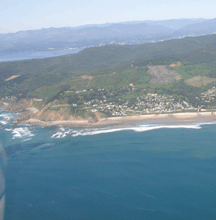Posted on Science 13 July 2012: Vol. 337 no. 6091 pp. 146-148 DOI: 10.1126/science.337.6091.146 — By Robert F. Service — Carbon dioxide emissions have changed the chemistry of the world’s oceans in ways that are already harming shell-building organisms and could lead to broad impacts on marine ecosystems.

Tip of the spear. Acidity levels in Netarts Bay, Oregon, hit levels the rest of the ocean won’t see for decades.
NETARTS BAY, OREGON—Alan Barton hates beautiful summer days. Not the warm sunshine—here on the central Oregon coast, where it is cold and rainy for much of the year, sunshine is welcome. Rather, for Barton, an oceanographer who helps run an oyster larvae hatchery here, it’s the breezes he can’t stand.
When the wind blows from the north as it normally does in the summer, it pushes the surface waters out to sea, drawing up cold water from the deeper ocean. That water is enriched with carbon dioxide (CO2), given off by microbes as they metabolize organic matter that sinks to the ocean bottom. When the CO2-rich water washes into Netarts Bay and the intake pumps and oyster larvae tanks at the Whiskey Creek Shellfish Hatchery, the excess CO2 causes the seawater’s acidity to spike and reduces the amount of carbonate ions that oyster larvae use to build their shells.
The change can kill oyster larvae instantly or stunt their growth. In 2007 and 2008, Whiskey Creek lost 80% of its annual larvae production and nearly had to close up shop before Barton, working with regional scientists, fingered rising ocean acidity as the source of the problem. Now, the hatchery copes with fluctuations in pH by making sure to draw water into its tanks only after acidity declines. But even that success has left Barton frustrated. “This is what I like to do,” he says, shucking an oyster. “I hate thinking about carbonate chemistry.”
The reprieve for Whiskey Creek and other shellfish hatcheries and farms along the West Coast of the United States could be short-lived. The burning of fossil fuels emits some 35 billion metric tons of CO2 into the atmosphere every year. That has already begun to change the fundamental chemistry of the world’s oceans, steadily increasing their level of acidity. On page 220, scientists in Switzerland and the United States report projections from a new high-resolution computer model showing that over the next 4 decades, the combination of deep-water upwelling and rising atmospheric CO2 is likely to have profound impacts on waters off the West Coast of the United States, home to one of the world’s most diverse marine ecosystems and most important commercial fisheries.
The new computer model is only one of several recent warning signs. Numerous laboratory and field studies over the past few years underscore rising concerns that ocean acidification could devastate marine ecosystems on which millions of people depend for food and jobs. The new results “are a major concern,” says Richard Feely, a chemical oceanographer at the National Oceanic and Atmospheric Administration’s Pacific Marine Environmental Laboratory in Seattle, Washington. “It’s dramatic how fast these changes will take place.” George Waldbusser, an ocean ecologist and biogeochemist at Oregon State University, Corvallis, says it’s not clear precisely how rising acidity will affect different organisms, but the changes will likely be broad-based. “It shows us that the windows of opportunity for organisms to succeed get smaller and smaller,” he says. “It will probably have important effects on fisheries, food supply, and general ocean ecology.”